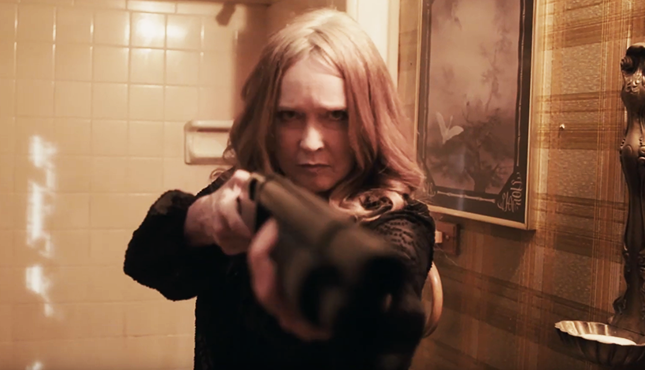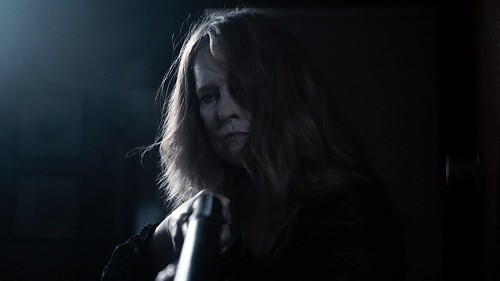Movies & TV / Columns
Sam Farmer On Choosing Cry for the Bad Man As His Next Film, Camille Keaton Getting Involved

The 411 Interview- Sam Farmer
Sam Farmer is a writer, director, producer, cinematographer, editor, and actor who has worked on such movies as Veer!, Girl of my Dreams, and Gore-e-ography: The Making of Death Harmony (check out his IMDB page here). Farmer’s latest movie is the mega low budget siege thriller Cry for the Bad Man starring horror genre icon Camille Keaton. In this interview, Farmer talks with this writer about making Cry for the Bad Man, working with Camille Keaton, his moviemaking heroes, and more.
**
Bryan Kristopowitz: Why did you want Cry for the Bad Man to be your next movie as a director?
Sam Farmer: The opportunity to work with Camille Keaton was the primary motivation. Being an unknown filmmaker means struggling to find an audience and having a name attached definitely puts asses in the seats.
BK: Was Cry for the Bad Man always intended to be a movie? The screenplay, at least to me, seems like it could be a play.
SF: It was always intended as a feature, but my approach to writing is a lot like black box theater. It helps with low budget filmmaking where you want to be economical with the limited resources you have.
BK: How did Camille Keaton get involved?
SF: Camille was introduced through a mutual friend — our associate producer, Jerry Rosenberg. Jerry has known Camille for 40+ years. Jerry hired me to help edit the video portion of a one woman show he was producing for Christina Crawford (author of Mommie Dearest). During our time on that project, he’d seen a few short films I’d directed and thought I should meet his “friend.” At the time, I didn’t know his friend was Camille Keaton, so that was a shock. We pitched her a rough concept based on her filmography and her own personal interests. She graciously accepted and we got to work.
BK: How did you cast Cry for the Bad Man?
SF: Some of the cast were people we’d worked with on previous projects. Christopher James Forrest, Karen Konzen, Mark Poppleton, and Kurt McCall were all people I’d known from other commercial and film projects. The rest of the cast auditioned. They’ve all since become good friends and regular collaborators.
BK: How long did it take to make Cry for the Bad Man, from completing the screenplay to finishing post-production?
SF: 6 years. We pitched Camille at the beginning of 2013 and were partnered with a production group to finance the film by summer. That fell through and we had to put the project on the backburner. The producer, Corina Farmer (my wife), and I spent about 2 years developing and filming promos with Mark Patton for what would become Scream, Queen: My Nightmare On Elm Street. We’d left that project by 2015 and handed the reins to Roman Chimenti and Tyler Jensen (I stayed on and animated the opening title sequence). Summer 2015, we filmed the proof of concept trailer for Cry with Camille and began to look for money. By 2017, I’d brought Jonathan Shepard onboard who’d produced a number of films (Velvet Road, Devil Incarnate) and partnered with our executive producer Kathryn McAvoy. Production was much faster. Contracts were signed in October and we began filming in November. 11 days (and nights) of production. Everything went smooth. A year of post- production (there was no proper budget for post, so it was mostly sweat equity and asking favors) plus a couple pick-up shots during spring and summer of 2018. It was out on the festival circuit by January 2019.
BK: Where was Cry for the Bad Man filmed? Was the house set used in the movie an actual house?
SF: The film was shot in Fruit Cove, in St Johns County Florida. Interiors were filmed in Orange Park Florida. The house is a combination of two locations. Most of the exteriors were filmed at our executive producer’s house in Fruit Cove (the MacMohan barn was at this same location) and the interiors were done in a separate house in Orange Park — unlike the isolated exterior scenes, the house used for the interior was in the middle of a neighborhood with houses on all sides. Not nearly as isolated.
BK: What was the hardest part of making Cry for the Bad Man? What was the easiest?
SF: The hardest part is always what you don’t see: Pitching the film, scheduling, beta-testing SAG-AFTRA’s online signatory process, dealing with contracts, dealing with lawyers, fighting with agents, clearing songs, and every other soul-sucking behind-the-scenes thing that happens before and after making the movie itself. The easiest part was the 11 day shoot. Every shot was meticulously storyboarded. We breezed through 72 pages with everyone in great spirits.
BK: How difficult were the movie’s practical special effects to film?
SF: Practical effects are mandatory with a film like this. My day job is in post-production where I’m often doing visual effects compositing and 3D animation, but I knew an old school genre picture like this deserves real, visceral effects captured in camera. It’s always 50/50 with practical effects. When you’re blowing something up, you’re bound by physics. You can’t get an explosion to behave. If a shot works, great! We move on. If it doesn’t, everything has to be cleaned up, reset, and the process starts all over. Jeh Howell (Zombieland) of Factory Of Effects handled the effects. He made my life easier on set.
BK: How did you put together the movie’s soundtrack?
SF: Franko Carino is an old friend. We’d played in bands together going back almost 20 years now. In recent years, he’d been touring with Limp Bizkit triggering their drum loops and samples for the live show, but I’d always known him as an industrial music producer and pianist, so I knew he had the chops. I gave him a cut of the film, a few references of what we wanted, and he wrote most of the soundtrack while on tour in Europe. The song featured in the film is by a band called Ghostwitch. The song is called “Sweetness” and it had just the right amount of grit to bring out Marsha’s dangerous side. Camille’s sort of like that in real life. Just because she’s in her 70’s doesn’t mean she won’t turn up Skid Row once in a while.
BK: You were credited as “Samuel Farmer” in your previous movie Girl of my Dreams. You are credited as “Sam Farmer” for Cry for the Bad Man. Why the change?
SF: Girl of my Dreams was a project I’d written to spec for another filmmaker. I was signed on to DP the film, not direct. The director left the film 6 hours prior to the first day of filming citing family reasons and we scrambled to save the project. It never felt like my film and I suspect the name credit came from an IMDB entry that I hadn’t created. I’ve since tried to clean it up, but my credits are incomplete. One day I’ll sort it out.
BK: Any movie making heroes?
SF: John Carpenter and Debra Hill. Beyond the films that they produced together (and separately), there are all these amazing stories about the atmosphere they created on set and the loyalty they had to their film family. Hill spent Christmas Eve in the hospital with a set photographer who’d broken her foot. Dean Cundey turned down Spielberg to shoot Halloween III: Season of the Witch. John and Debra used the location change in filming Escape from New York to get all their USC film school friends into the union. Filmmakers often idolize the bad behavior of directors, writing it off as “eccentric,” but I don’t find it useful being a dick to an actor just to manipulate some performance out of them. Kubrick could get away with it. Paul Thomas Anderson can get away with it. I can’t. I wouldn’t want to.
BK: Any upcoming projects you can tell us about?
SF: We’ve filmed another proof of concept pitch for what we hope will be our next feature along with a couple of short films. Right now, there’s a lot of uncertainty about when these things can happen with Covid-19, so our primary focus is staying safe and helping Cry for the Bad Man find its audience.
BK: What do you hope audiences get out of Cry for the Bad Man?
SF: For fans of Camille Keaton, I hope they see this as a true return to form. Camille is often shoe-horned into cameo roles as the mother or grandmother these days and given very little to do. We wanted to give her a proper Clint Eastwood shoot ‘em up to hang her hat on (but with 2% of the budget). She’s not just passing the torch or making a cameo. She’s front-and-center.
BK: Will there ever be a Cry for the Bad Man 2?
SF: I’d hope that no one in that small town would be dumb enough to mess with Marsha Kane after what she does to these guys, but this is the south. “Florida Man” has made headlines for stupider things.
BK: Have you ever played cards with your friends in a barn?
SF: Ha! If you drive through Jacksonville at night, any barn, shed, or open garage with a “Don’t Tread On Me” flag hanging above it is bound to have some militia types gambling and drinking. It’s best to avoid them, unless you need to buy speed.
**
A very special thanks to Sam Farmer for agreeing to participate in this interview and to Clint Morris for setting it up.
You can buy Cry for the Bad Man on DVD here, and watch it via Amazon Prime Video here (it’s also available on various other Video On Demand portals).
Check out the Cry for the Bad Man Facebook page here.
Check out my Cry for the Bad Man review here.
Images labeled (A) and (B) courtesy of Uncork’d Entertainment. All other images courtesy of Sam Farmer.












